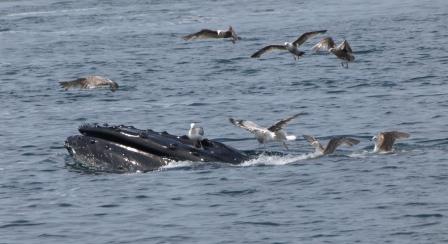Whalewatching

VulcanSpirit
Richard & Alison Brunstrom
Sun 3 Jul 2011 21:39
|
Cape Cod is one of the best places in the world to
watch whales - several species come here to feed in the rich waters off the
coast. At this time of year Humpbacks are the most common, but Minkes are around
too, and if you're really lucky a Northern Right Whale (tragically there are
only about 300 of these left, and despite the cessation of hunting in the 1960s
numbers have not recovered for as-yet unknown reasons). However the Humpbacks are doing well after losing about 90% of their
world population before hunting stopped in 1966; there are currently about 80
000.
The Humpback Megaptera novaeangliae is a
baleen whale (sieves its food through baleen plates, unlike the toothed whales)
which reaches 16m in length and weighs up to 36 tonnes; the biggest animal ever
to have lived is also a baleen whale, the Blue Whale; it lives on tiny
crustaceans that it filters out of the sea. Humpbacks, which migrate an amazing
25 000km per year, have recently been shown to live far longer than
previously realised - over 200 years - and live on fish.
Here is the diagnostic humped back with very small
dorsal fin. Note how close the shore is.
 Humpback surfacing showing underside of jaws. Note
the large patch of barnacles adhering to its skin (the light coloured patch
between the two sets of white stipes).
 These whales have been 'bubble feeding' in small
groups. They dive to the bottom then swim in a circle releasing bubbles which
herd their prey (small fish) into a tight group near the surface,
whereupon the whales suface and swim open-mouthed through the shoal gulping
up fish, and water which then drains out through the baleen plates leaving the
whale with a mouthful - a very big mouthful - of tasty fresh fish. You can see
the bubbles still rising in the picture below, and the whale in the centre
(there are three individuals on the surface here) swimming on its back with its
very long white flippers out of the water (megaptera = long wing in
Latin).
 And here is another whale feeding on the surface.
Note the gulls which congregate around the surfaced whales hoping to get a few
fish. The birds often land on the whales' snouts, as one has here. The tubercles
on the whale's snout are modified hairs (all mammals have hair) used to sense
their prey when rooting around on the seabed.
 And here is the tail of a diving whale. Unusually
for whales the markings are unique and enable individuals to be identified thus
greatly aiding scientific study
 |